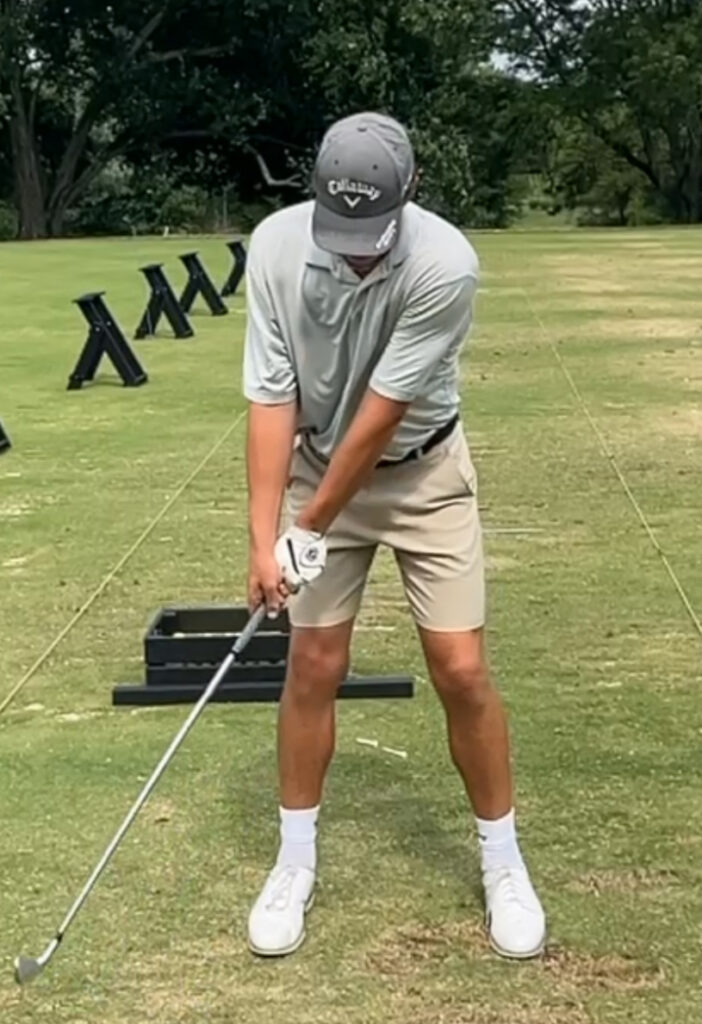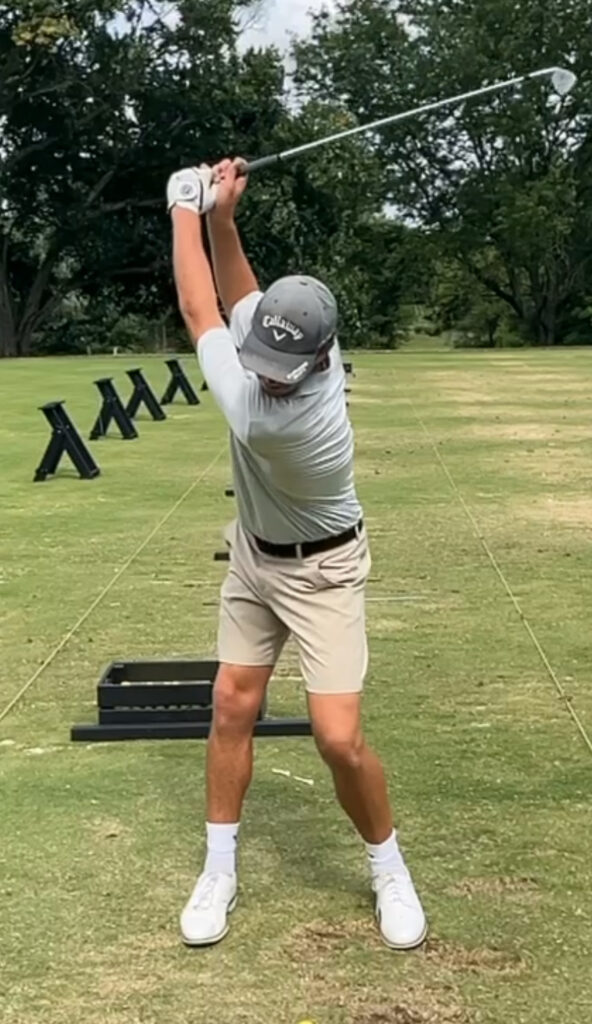Overcoming Competitive Anxiety in Golf
Mastering the Mental Game: Proven Strategies to Overcome Competitive Anxiety in Golf and Boost Performance
By Kevin Cotter, PGA
Competitive anxiety in golf can significantly hinder performance, especially in high-stakes environments. Golf is unique in combining intense concentration, physical precision, and a slower pace that gives anxiety more time to build. Here’s an in-depth analysis of managing and overcoming competitive anxiety while improving performance.
Competitive anxiety often manifests as nervousness, worry, or tension before or during a round. It results from overthinking outcomes, self-imposed pressure, or fear of failure. It impacts performance in two key ways: physical symptoms, such as muscle tension, sweaty palms, elevated heart rate, and difficulty breathing, and cognitive symptoms, such as negative thoughts, including self-doubt and loss of concentration, which can disrupt decision-making and focus.
Mental strategies to combat anxiety include several effective mental techniques that can aid in reducing anxiety and stress, such as visualizing successful shots, calm conditions, and positive outcomes. Visualization helps “program” the mind to expect success, reducing anxiety.
Establish a consistent pre-shot and pre-round routine to create a sense of control and familiarity. These routines help you get into a “zone” and can minimize mental distractions.
Replacing negative thoughts like “Don’t hit it in the water” with positive ones like “I’ll aim for the center of the green” reduces anxiety.
Mindfulness also plays a significant role by allowing one to focus on the present moment rather than worrying about past mistakes or future shots. This technique and deep, controlled breathing can calm nerves during high-pressure situations. Examples include box breathing, inhaling for 4 seconds, holding for 4 seconds, exhaling for 4 seconds, and holding again for 4 seconds. This technique calms the nervous system and lowers stress. Also, focus on the process, not the outcome; anxiety often comes from focusing on scorecards, competition, or possible failure. Instead, concentrate on the process (e.g., executing a smooth takeaway or a precise putt).
Celebrate small wins, such as reflecting on what went well (even something minor like a good putt or making solid contact). Celebrating incremental successes builds confidence and lowers anxiety.
When mistakes do happen, review them calmly and rationally after the round rather than during play. Recognizing them as learning opportunities reduces the fear of failure in the future.
Another anxiety reducer lies in swing tempo practice. Anxiety often leads to rushed swings and poor timing. Practicing slow-motion swings can help build muscle memory for smoother, more relaxed movements. Focus on rhythm rather than power during your round. Staying committed to a steady tempo helps reduce over-swinging, which is often a result of anxiety.
Another helpful tip is to simulate pressure situations in practice. By incorporating pressure scenarios into practice rounds (e.g., making a putt to “win” a competition), you become increasingly accustomed to performing under stress, desensitizing the brain to anxiety.
Confidence is also a critical factor in reducing anxiety. It comes from knowing your skills are solid. The more competent you feel, the less anxious you will be.
Play within your abilities Instead of always going for difficult shots (which increases anxiety), focus on managing your game with strategies that fit your skill level—aiming for the middle of the green rather than going directly for the pin. There are times to take risks and times to play conservatively. Choosing the right time for each helps avoid unnecessary stress and anxiety on challenging holes.
While the strategies mentioned above can help in the short term, building a long-term approach to managing anxiety is also crucial through meditation and relaxation and even a sports psychologist if all else fails.
The more competitive situations you expose yourself to, the more accustomed you’ll become to handling pressure. Regular tournament play, even in low-stakes events, helps reduce anxiety over time.
Overcoming competitive anxiety in golf requires a combination of mental, physical, and technical approaches. Golfers can significantly reduce stress and improve performance by building confidence through preparation, employing relaxation techniques, managing expectations, and refining practice habits. These strategies help overcome short-term nervousness and build a long-term mindset that thrives under competitive pressure.
The Perfect Takeaway
Mastering Your Golf Swing’s First Move
By Kevin Cotter, PGA
The golf swing begins with a unified movement of the clubhead, hands, arms, and shoulders. This movement, known as the “one-piece takeaway,” ensures that all upper body parts move harmoniously. Following this initial action, the hips start to rotate, responding to the movement of the shoulders. As the hips turn, the lower body—knees and feet—follow as the weight shifts back, over, and around the rear leg.
During the latter stages of this one-piece takeaway, it’s crucial to eventually allow the right elbow to fold naturally against your right side as the club continues back and up. This technique keeps the arms connected to the body, maintaining a compact and controlled swing.
The one-piece takeaway sets the initial rhythm and pace of the swing and syncs the sequence of movements: clubhead, hands, shoulders, hips, and then the lower body. This order is vital for correctly coiling the upper body against the lower body, creating a spring-like mechanism that unleashes substantial power during the downswing.
Proper takeaway execution is also fundamental in harnessing power through angular momentum, often referred to as the “lever system.” Effective use of this system is key to generating tremendous force and enabling a ball-first, then turf contact—essential for tight lies. Furthermore, striking the ball with a descending blow is critical; it imparts the necessary spin for the ball to stick in the landing/target area.
Additionally, the natural flow of the one-piece takeaway greatly influences the club’s path. Ideally, the club should move straight back, then slightly inside, before turning upward. This motion ensures that the club follows a similar, semi-circular path on the downswing, facilitating a clean and consistent strike from the ball through to the follow-through.
Contrarily, forcing the club too quickly to the outside or inside during the initial backswing can disrupt this path, leading to potential mishits like pulls or slices. Thus, mastering the one-piece takeaway is crucial as it lays the foundation for a powerful, repeatable golf swing, enabling consistent, clean, straight shots.
This detailed guide to the one-piece takeaway improves your initial swing motion and lays the foundation for a powerful, precise, and consistent swing.
Master Your Swing Today!
Two Swing Tips You Can Use From Scottie Scheffler’s Olympic Gold Medal Win
quick coaching
By Ryan Adams, PGA
Published on Monday, August 5, 2024
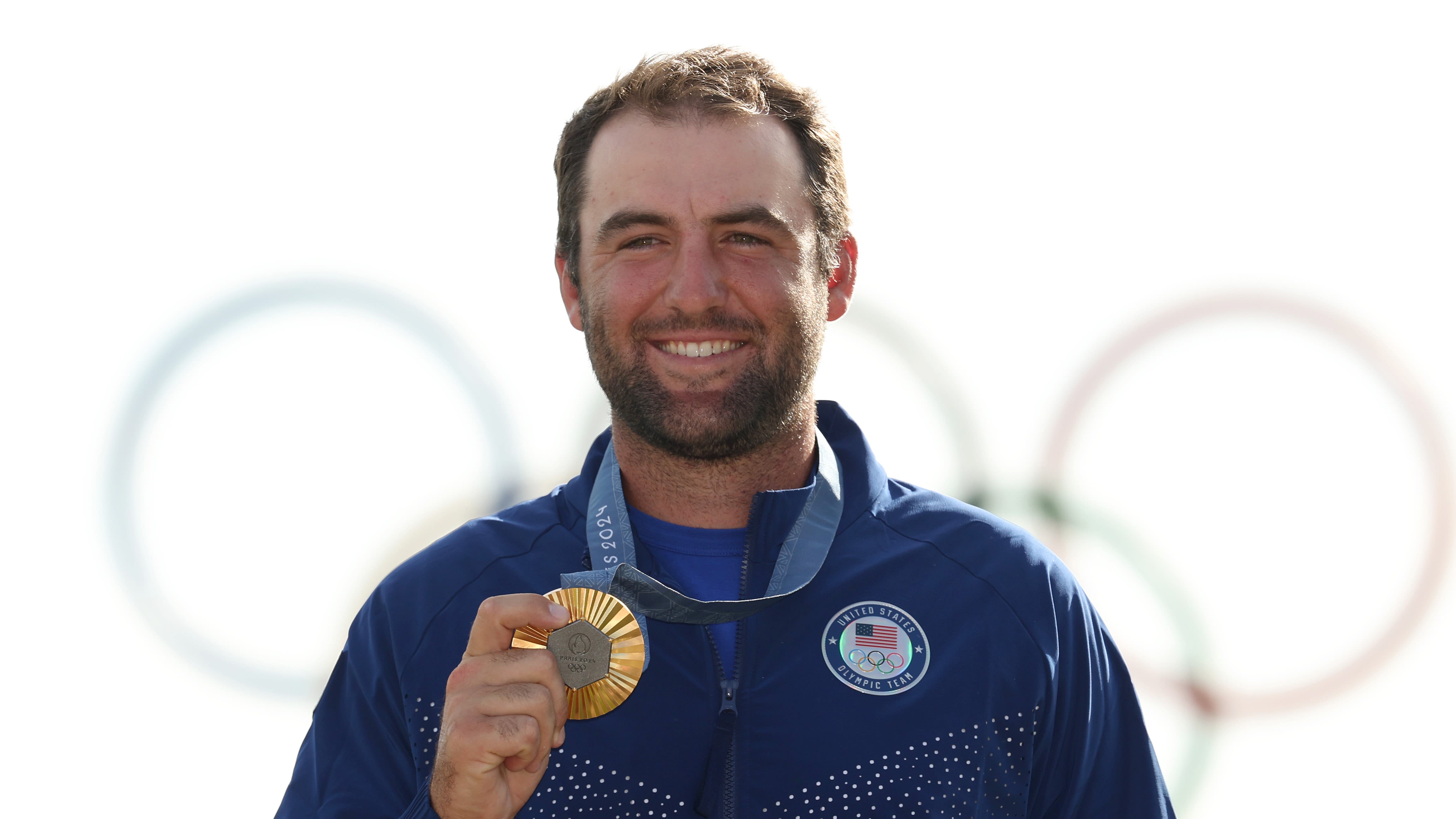
It’s been quite an Olympics in Paris so far, hasn’t it?
Adding to the fervor was the Men’s Golf competition at Le Golf National, which ended with dramatics, star power and a medal decision that went right down the final hole.
In the end, as he’s seemingly done all year, it was the USA’s Scottie Scheffler finishing with the gold medal after a scintillating back-nine 29 to finish at -19. Great Britain’s Tommy Fleetwood finished one back at -18 to take silver, while Japan’s Hideki Matsuyama nabbed the bronze medal.
Scheffler’s play this year has been something to marvel at. He’s having a historic ballstriking season, and its his iron play that allowed him to stay within reach of the podium for the first three rounds . . . and then pounce in the final round with a magnificent 62.
So, you may be thinking, “What could I possibly learn from such a good golfer like Scottie?” Well, in fact, there’s a lot. But we’ll focus on two things that stood out at Le Golf National.
Solid iron play begins with solid fundamentals
One of things you have to admire about Scheffler is his commitment to always being in a fantastic position to strike the golf ball. His grip, posture, setup? They’re flawless.
But that’s also because he’s always checking to make sure things stay squeaky clean. It can be easy to shift your feet (no pun intended with Scottie) open or closed, maybe grip a little tighter, or be a little more rounded in your posture. Believe it or not, when Scottie starts his warmup each round alongside his longtime PGA Coach Randy Smith, he practices with a molded grip club to make sure his hands are sound.
Here’s the club at this year’s PGA Championship while Scottie was getting ready at Valhalla:
One of those molded-grip clubs is only $10-11 at your local sports store, so it might not be a bad purchase. Aside from your grip, if you’re heading to practice or play this week, try these tips:
- Scottie’s shots never seemingly left his target at Le Golf National. Everything is aligned to where he wants his ball to go. Try this: At the range, or even on the course, find your target. Then find something draws a direct line between your target and you maybe 3-4 yards in front of you. It could be some grass, a divot, a dead turf spot – whatever it is, align to that so you know you’re aiming at your target hundreds of yards away.
- Another key to good iron play is focusing on good compression. Scottie’s iron strikes sound different because he compresses the ball so well, with ball first, divot second contact. Try this: On your downswing, focus like you’re covering the ball with the center of your chest. Try half-swings with your wedges to dial in this concept first. Your hips should rotate open and then your chest center will “cover” the ball,” giving you a solid spine angle position that compresses the ball. Work your way up from wedges to irons and you’ll start feeling more confident.
Don’t forget to just have fun
To start the week, the Olympic Golf social media team had players take to mini white-boards like their first day of grade school and write a few fun facts about themselves.
The last question on each board was, “What’s your Paris goal?” Here’s what Scottie’s said:
While this isn’t a technical swing tip, it’s something a lot of golfers forget. Sometimes we get so caught up in the nitty-gritty of swing mechanics and pressures and “Why didn’t you make this putt” that it takes the joy away from playing the game.
Now, is it easier for Scottie to “just have fun” since he’s the best player in the world? Yeah, probably. But his Paris goal is wisdom for us all, no matter how good or bad we are at golf. That mentality helped Scottie all the way to the gold medal at Le Golf National and it can probably help you with your own golf goals. Think about these two thoughts the next time you tee it up:
- If a bad shot happens, instead of wondering what went wrong, focus on what you can do on the next shot to minimize the damage. Leave that bad shot behind where it deserves to be. It’s easy to let it ruin your round . . . but what’s the fun in that?
- Once you’re out on the course, let the mechanics go. Golf gets to be not a lot of fun when you’re trying to keep your lead arm straight on the 11th hole or hinge your wrists on a chip to get up and down for par. Instead, remember those fundamentals we talked about, set up and let it rip.
Hopefully these small pieces of advice have you on your way to playing better – whether it’s for an Olympic medal or a few dollars from your buddies.
Five Keys to Hit Your Fairway Woods Better
QUICK COACHING
By Brendon Elliott, PGA
Published on Saturday, June 29, 2024

In Thursday’s first round of the Rocket Mortgage Classic, Cam Young hit a beautiful fairway wood from 273 yards to 3 feet. Fairway wood shots like this are shots that most amateur golfers can only dream of hitting. For most, just getting a fairway wood airborne is a significant achievement.
Struggling to hit fairway woods consistently off the deck, or the tee? You’re in good company.
Many golfers grapple with these longer clubs. But fear not, with the right techniques and practice, you can start hitting fairway woods better and add some serious distance and accuracy to your game.
Try these tips:
Get Fairway Woods That Suit Your Swing
First and foremost, it’s crucial to have the correct fairway woods in your bag. The loft and shaft flex should suit your swing speed and personal preferences. Once you have the right club, it’s time to focus on your setup and swing.
Trust The Equipment
Another key element is to trust the club’s loft. Fairway woods are designed to provide lift, so avoid trying to help the ball into the air by scooping or flipping your wrists at impact. Instead, trust the club’s loft and focus on making solid, confident conta
Understand How To Hit a Fairway Wood Properly
When hitting fairway woods off the fairway, a common mistake is to try and lift the ball into the air. Instead, focus on making solid contact with the ball at impact. Position the ball slightly forward in your stance, just inside your front heel. This setup promotes a slightly descending blow, ensuring clean contact with the ball.
Rhythm & Tempo
In terms of the swing, it’s essential to maintain a smooth tempo and rhythm. Fairway woods are designed to sweep the ball off the turf, unlike hitting irons, where you may take a divot after the ball. To achieve this, focus on a shallow angle of attack. Stay behind the ball at impact and maintain your spine angle through the swing. This will help you strike the ball cleanly and get the ball airborne.
Nelly Korda’s Swing Tempo Tips
INTERMEDIATE
Golf Tips: Copy Nelly Korda’s Swing Tempo With These 3 Keys
By Brendon Elliott, PGA
Published on Saturday, April 20, 2024

With no disrespect to Scottie Scheffler and his dominance in the men’s game, Nelly Korda may be the best golfer on the planet right now. Going for her fifth straight win this week at The Chevron Championship, the LPGA’s first major of the year, Nelly sits in a very familiar place near the top of the leaderboard.
One of the most striking things about Nelly’s swing is its fluidity. Her motion is smooth and graceful, with no wasted or unnecessary movements. Her natural rhythm and tempo allow her to generate power without sacrificing accuracy.
Another key element of Nelly’s swing is her balance. She maintains a stable base throughout her swing, which allows her to continually make solid contact and control her shot trajectory. Her weight shift is subtle and controlled, which helps her to maintain her balance and generate power.
Nelly’s swing also features a high level of coordination between her upper body and lower body. Her hips and shoulders rotate in a way that creates proper resistance between each other, allowing her to generate torque and power. Her arms and hands remain relaxed and passive, allowing the club head to do the work.
Of course, Nelly’s swing didn’t develop overnight. It has taken years of hard work and dedication to reach the level of proficiency that she now possesses. The following three tips can help you find better balance, fluidity, and rhythm in your swing, but, just like with Nelly, it will take some time to really get things dialed in.
Focus on your posture
Maintaining good posture from set up and throughout your swing is essential for achieving balance and fluidity. As you get set, focus on keeping your spine and sternum steady and over the ball, with your weight evenly distributed and your feet shoulder-width apart. This will help you maintain your balance throughout the swing.

As you move throughout your swing, always try to maintain that feeling of centeredness, with those critical points of the spine and sternum steady and over the ball.
Practice your transition
Many golfers lose rhythm and fluidity during the transition between the backswing and downswing.

To improve this, practice your transition by slowing down your swing and focusing on the smoothness of the movement. Once you have mastered a slow and smooth transition, gradually increase your speed until you can maintain the same fluidity at a faster pace.
Use your hips correctly
A consistent and solid golf swing relies heavily on using your hips correctly. This helps generate power and maintain fluidity. Additionally, it allows for a consistent strike at impact and a reliable shot shape. Check out this sequence from Nelly:
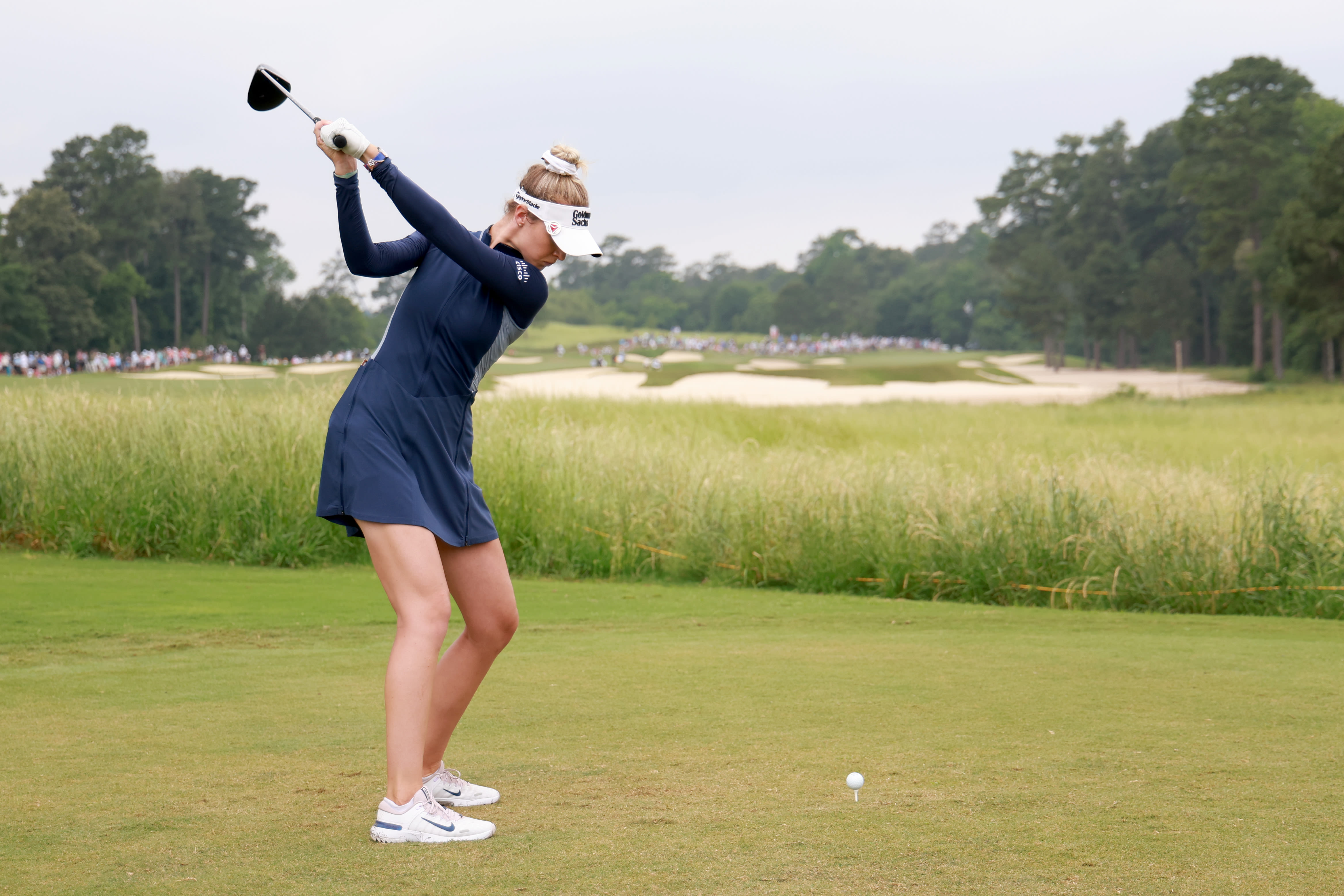

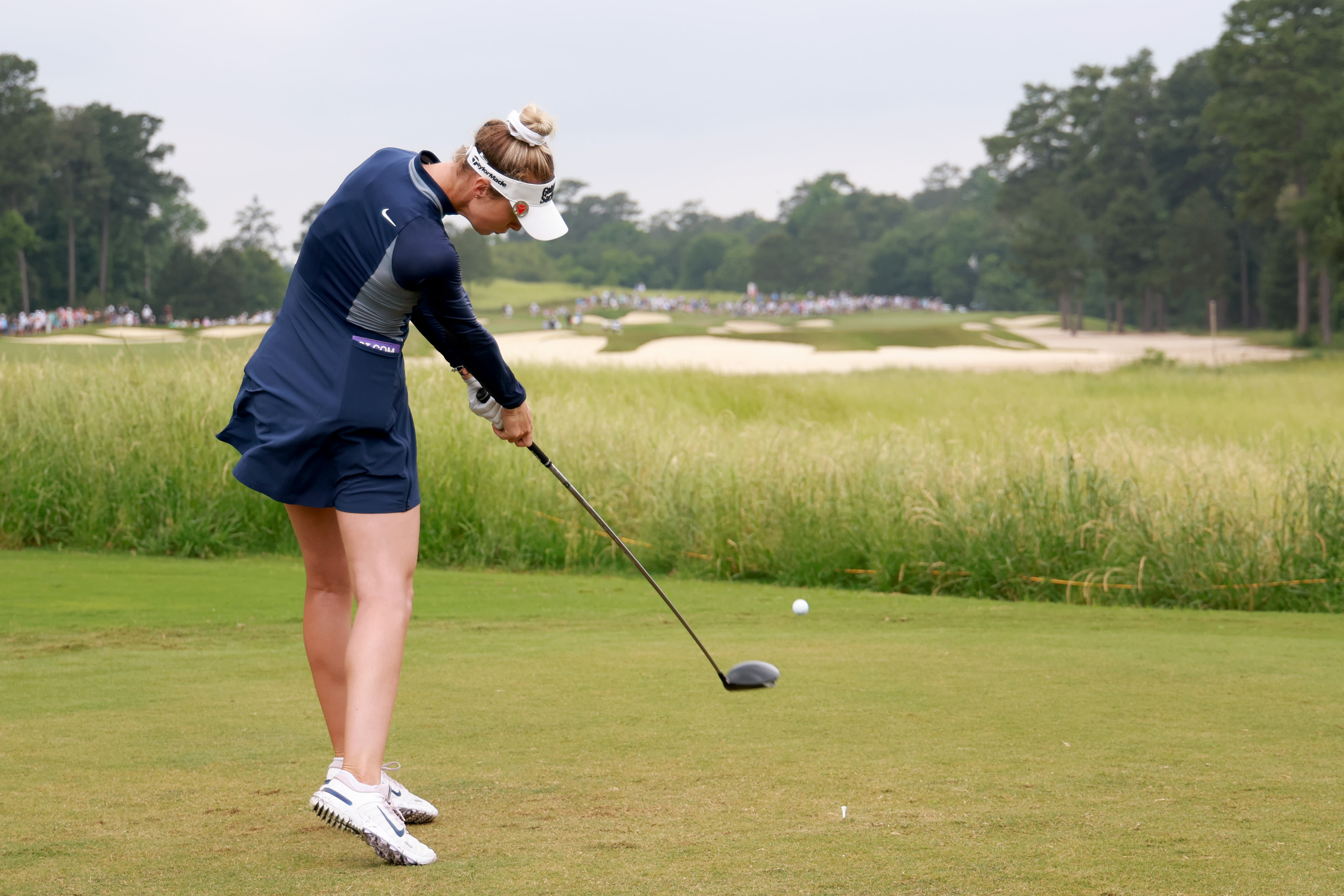
Notice Nelly rotating her hips throughout the swing, starting with her backswing and continuing through to your follow-through. As you swing back, your hips should rotate around 45 degrees, with your upper torso rotating an additional 45 degrees beyond that. That resistance between your upper body, rotating closer to 90 degrees, and your 45-degree hip turn creates the wind-up, which is necessary for you to be powerful once you transition down from the top of the swing.
As you unwind in the downswing, your hips must lead the way and rotate out of the way so that your hands and club can approach the ball from the inside. Hips that do not clear properly in the downswing create problems with consistency in your swing.
Catch some coverage of The Chevron Championship this weekend . . . there’s a lot you can learn from one of the LPGA’s stars who’s on an unreal run!
Try This Drill to Cure Your Slice
QUICK COACHING
Golf Tips
Published on Tuesday, April 2, 2024
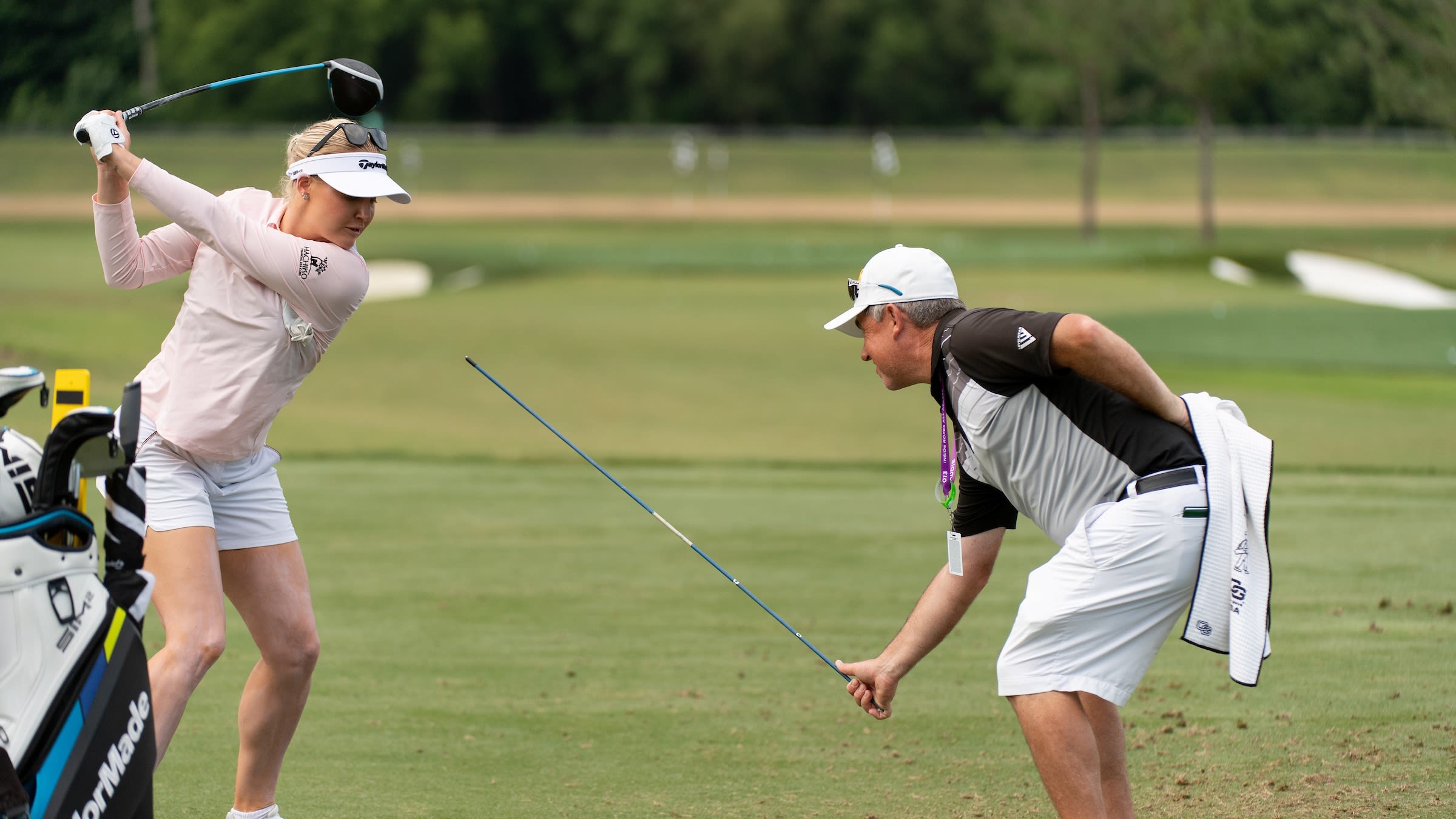
The slice is enemy No. 1 for a lot of golfers. And it’s easy to see why.
A slice curves away from the target pretty quickly and zaps distance, making tee shots and approach shots less likely to find the fairway and green. The result? Higher scores.
Slicing the ball is a common fault because it’s a combination of a lot of common miscues but none more prevalent than an over-the-top backswing and open clubface at impact. Those two combined make it easy for the ball to spin left to right (for righties, opposite for lefties), and away from the target.
The good part about a slice though, is just like any swing fault, it can be fixed with the right prescription. We asked Jimmy Wisinski, the PGA of America Director of Instruction at Kent Country Club in Michigan, to share a drill on how the combat the dreaded slice.
Jimmy delivered with a great alignment-stick drill that you can do the next time you hit the range:
Drain Putts Like Tiger Woods
QUICK COACHING
Struggling On The Greens? This Putting Drill Can Help Instantly
By Brendon Elliott, PGA
Published on Tuesday, February 20, 2024

Beyond some standard fundamentals, the art of putting is as individual as a fingerprint.
We all have unique factors influencing our approach to putting: our height, body type, tempo at which we walk and talk and, most impactfully, how we see a putt with our eyes all influence what we do with the flat stick, whether we know it or not.
We often force ourselves into a setup position that is too “squared off” or “technically sound” to allow our eyes to see that critical starting spot to roll the ball over just after impact.
Our brain, or subconscious, will actually reroute the putter on the downstroke if it feels that something is “off” visually when you make those last few looks with your eyes down the target line. This will lead to often funky-looking strokes and a potential massive loss of confidence.
If you’ve been experiencing some struggles on the green, not to fear. This drill below can help right away.
Find your spot
- With three golf balls, start with a putt of 6 feet on the practice green.
- Really focus on your putting line. Take a trip around the hole and see the line from all sides.
- Once you are confident on the line, find a point on your line about 4-6 inches past your ball and align the mark on your golf ball to that point. Pro tip: Using your golf ball mark is a critical part to being a good putter!
- As you start to get set up to the ball, make it a point to feel comfortable with what you see with your eyes as you are over the ball. How does the line on the ball look in relation to that intermediate starting point? How does your putter head look with regard to the ball and your intermediate starting point? Adjust your body, line, or even your putter head if it seems off a bit.
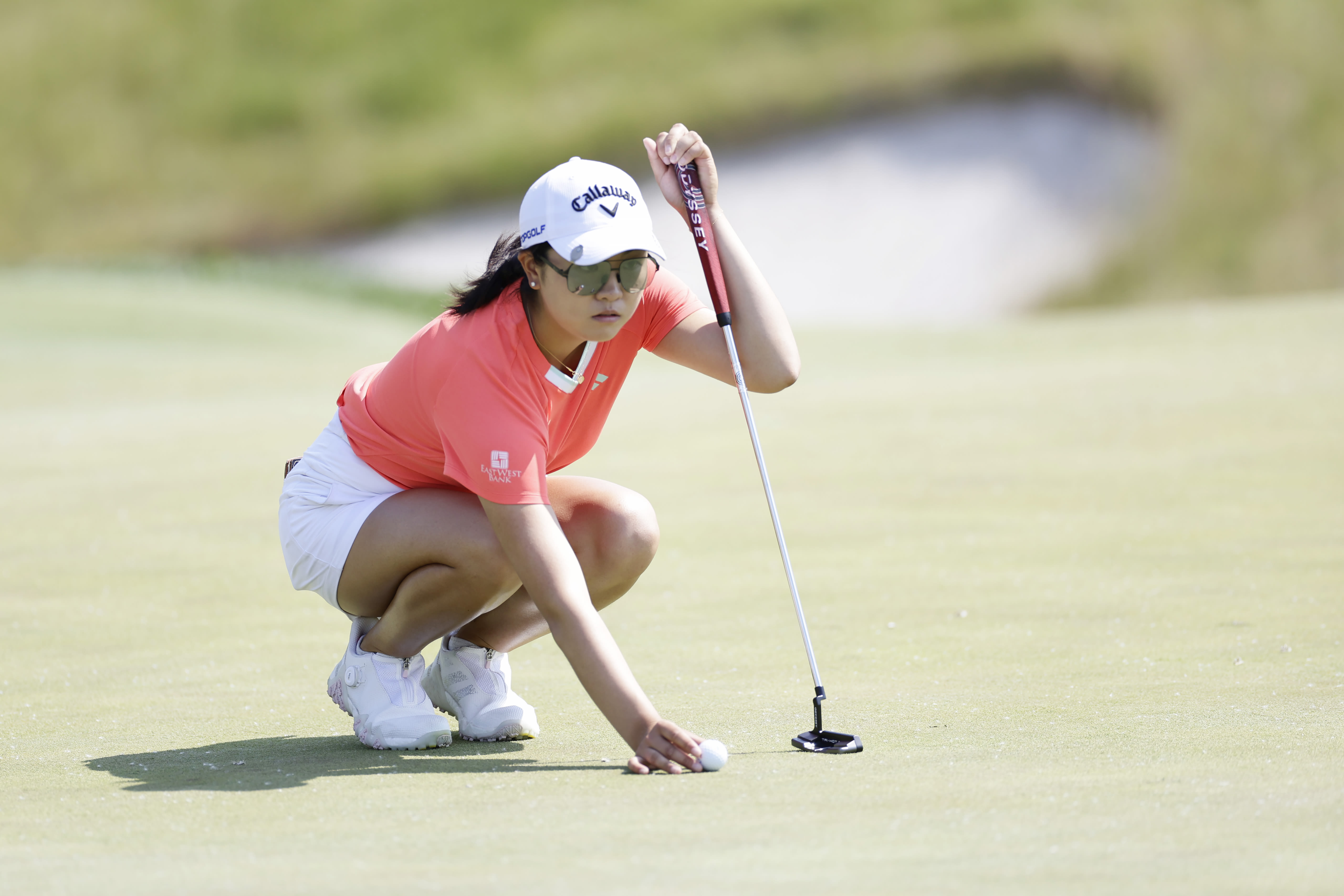
- It is critical to get your setup conditions correct in terms of what you see as you are over the ball and not necessarily in a way that feels more “technically sound.” Your eyes and instincts, unique to you, are far more critical in allowing you to roll the ball end over end and over that intermediate spot on your line.
Once you start continuously rolling the ball over that intermediate spot on your line, this drill will allow you to putt with more confidence and think less about how technically sound your putting may be. Technique is essential, but it often handcuffs golfers by not allowing them to stroke the putt freely and confidently!
Swing Tips from a Super Bowl Champion
QUICK COACHING
A Swing Tip You Can Learn From the NFL Quarterbacks Who Played in the Super Bowl
By Ryan Adams, PGA
Published on Sunday, January 28, 2024

A thrilling match-up for Super Bowl LVIII in Las Vegas on Feb. 11 ended as it should.
With drama.
The Kansas City Chiefs won their second straight Super Bowl, defeating the San Francisco 49ers 25-22 on a short pass play in overtime. The game was fun to watch, with high-flying offenses, stout defenses, plenty of storylines . . . and how could we forget Taylor Swift?
Believe it or not, though, there’s also a little golf lesson you can learn from the quarterbacks playing in today’s game.
Did you see how Patrick Mahomes (above) of the Chiefs and Brock Purdy of the 49ers were making their throwing motions? Well, there’s a lot of similarities between the way these quarterbacks sling it and how to create more powerful strikes with every club.
Let’s break it down.
Wind up and weight transfer
The first step for a quarterback is winding up their upper body and then transferring weight to the front foot to fire a pass. That’s a lot like the golf swing if you think about it: You make a full turn and then transfer your weigh to the lead side to maximize power. Look at Mahomes below as he steps into a pass:

He can’t make this throw without transferring his weight to the lead side. When they weren’t under pressure during the Super Bowl, Mahomes and Purdy started throws by stepping into them, and not hanging back. When you hang back on your trail side, there’s no energy going to the ball (or in the quarterbacks’ case, the pass) which makes it harder to create good contact.
Try this: Make practice swings with a full turn (shoulder under chin) and then on your downswing, take a step with your lead foot like you’re throwing a football or baseball. You’ll understand the proper sequence a lot better.
Unwind the lower body
Once you’ve made that first step, it’s time to unwind the lower body. You’ll see in the Super Bowl that the quarterbacks create space with their lower body by opening their hips and firing through with their upper body. Without that, it’s nearly impossible for them to make a proper move and throw the ball. Look at Purdy unwindingfor a big throw here:
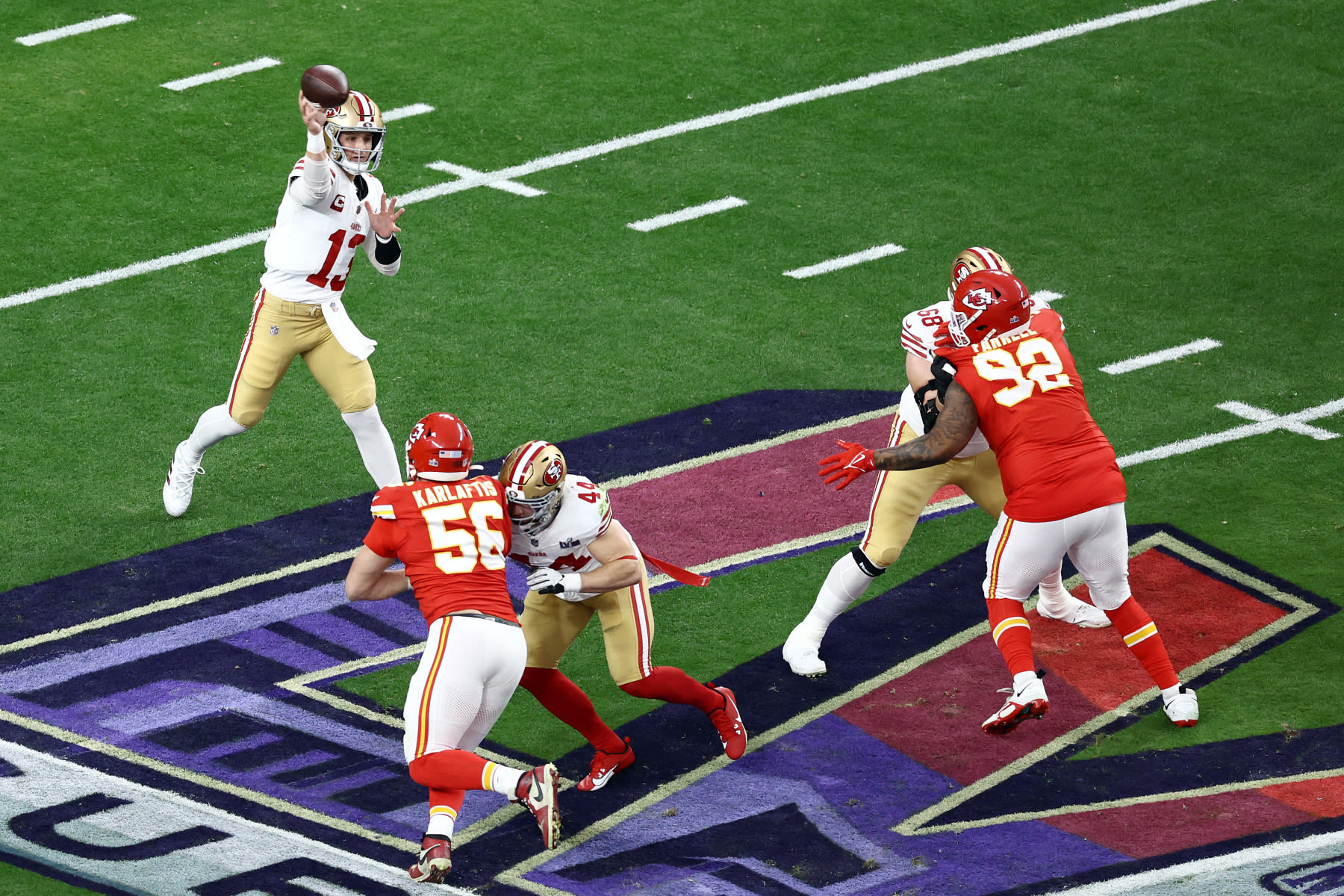
Same goes for your golf swing. There’s no way for you to hit the ball squarely without unwinding and rotating your hips to clear out space for the arms, hands and club. Not only are you clearing out space but because you made that move we described above in the first step, your sequence is right on and that means really good contact with the ball.
Try this: To understand this hip clear-out, get in stance and then take your lead hand and press it into your lead hip. You should feel an open rotation, or a “clearing out” of your lower body. Another way to think about this is if you had a belt on and tugged it with your lead hand. Attempt hitting a few half shots with this idea in place with your wedges.
Hopefully this two-part tip is something that will help you, like it helps these great quarterbacks on the NFL’s biggest stage.



